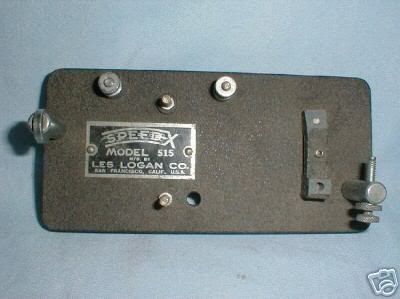The Brooks corollary to Murphy's Law states that “A missing/lost/desired item will be located immediately after the replacement item is acquired.”
This corollary typically applies to moving from one home to another. Where's a fly swatter when you want one? Or this time of year, a pair of gloves? You know you have them “around here somewhere,” but you need one today, so you drive to Wal-Mart and buy a replacement set of gloves, fly swatter, etc. The time delay varies, but I've found the “missing” items within minutes of opening the replacement item's blister pack. This explains why we have 9 fly swatters and 11 household flashlights.
Unbeknownst to me, I discovered recently the corollary also applies to telegraph keys and their parts
Remember the Les Logan Speed-X T-bar bug that needed a new damper? I broke half-a-dozen dremel cutting wheels trying to get this thing cut and shaped, and the final result looks fairly good and works fine.

Of course, just about the time I get the thing done, an auction shows up on eBay for a Speed-X bug base and several attached parts. There wasn't much left of the bug, EXCEPT the damper — the EXACT part I needed for my Speed-X key — the wire terminals and the dit contact post. The rest of the key was missing, and the pivot frame had been broken at the attachment screws on the base! Yikes! This poor bug suffered a fatal accident.
This is a model 515 bug, it used the same type damper as the EF Johnson bugs did, it was very similar to the Vibroplex keys and black in color. These dampers were made of pot metal, and they are fairly fragile and prone to shattering if dropped. I would say that's what happened to this key. I had a EF Johnson bug damaged the same way in shipping — the pivot from was shattered into small pieces. The bug had been wrapped in newspapers, and the top adjustment screw had hit so hard that it broke through the cardboard box. Obviously this key was bouncing around inside the box. Wadded-up newspaper has a way of becoming compacted during shipment.
The Speed-X base arrived today Priority Mail, and the damper looks fantastic on my key. I'll keep the homebrew one in the event I need it for another key.
The Speed-X base is really a nice shade of gray; the bug would have been a nice one for my collection if it was complete. I'm happy to have the parts however. I'll bet I've got another Speed-X bug that needs the correct style terminal nuts on it.
After installing the new damper, I took the key to the sink and gave it a bath in soapy dishwater. I read on another ham's web site that a good soaking helps loosen 50 years of gunk in all the nooks and crannies. If the key's survived this long, a dunking in the sink won't hurt it a bit.
The Speed-X has some paint loss along the back edge, which is a pity because the rest of it looks very good. A new paint job on the base is all it needs. It has a textured finish, not a krinkle finish, but a rough dull painted black finish. I'll have to see how to duplicate the finish style before I paint it. Most of my bodyshop experience was in making surfaces smooth and shiny; now it just needs to be smooth and uniformly textured.
Well, it's not exactly a rare key, but I just want it to look as original as possible. I've shifted a couple of keys off the desk to make way for it.
That's all for this installment … CU SOON … 73 de KY4Z SK ….. dit dit …..
UPDATE: The KSN was a wash tonight, the contest stations running RTTY filled the area from 3550-3600 kHz. Between transmissions I thought I could hear the NCS on 3579 kHz, but the din was too much to try to dig out a signal.
I left the rig but before shutting it down tonight I thought I might tune across 80 cw. The contest stations have calmed down, and there was a good bit of activity. I heard a station calling CW, so I tuned up and answered the guy. He was in Detroit and was pounding in.
I was running the Speed-X Model 500 that I was writing about above. I cleaned it up, polished the chrome parts and worked to fine tune its action. The keying lever seemed to drag a bit, and no amount of spring tension adjustment seemed to get it “right.” I don't like using oil on pivot points, but I decided the keying lever needed some help. I cleaned the pivot points and the screws (the screws on top and bottom have a hollowed-out recess that holds the keying lever's pivot in place. I put a dab of oil on the pivot shaft and the screws, wiping off the excess. After re-assembly, it sure made a world of difference in the key's action. The pivots must have really needed some light lubrication. I re-adjusted the key to reduce the keying lever's travel on the dit side, then adjusted the dot contact screw. The key really came into its own! It was at this point I thought no matter how late, it's worth taking this key out for a test drive.
We had a nice QSO going, and on the fourth transmission he simply disappeared. He never signed out (I was running QSK and could have heard him break me), he just never came back after I turned it to him.
That's all for now … more tomorrow. de KY4Z … dit dit …
